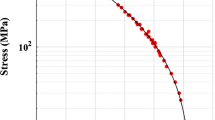Abstract
A critical review of recent creep studies concluded that traditional approaches such as steady-state behavior, power law equations, and the view that diffusional creep mechanisms are dominant at low stresses should be seriously reconsidered. Specifically, creep strain rate against time curves show that a decaying primary rate leads into an accelerating tertiary stage, giving a minimum rather than a secondary period. Conventional steady-state mechanisms should therefore be abandoned in favor of an understanding of the processes governing strain accumulation and the damage phenomena causing tertiary creep and fracture. Similarly, creep always takes place by dislocation processes, with no change to diffusional creep mechanisms with decreasing stress, negating the concept of deformation mechanism maps. Alternative descriptions are then provided by normalizing the applied stress through the ultimate tensile stress and yield stress at the creep temperature. In this way, the resulting Wilshire equations allow accurate prediction of 100,00 hours of creep data using only property values from tests lasting 5000 hours for a series of 2.25 chromium steels, namely grades 22, 23, and 24.








































Similar content being viewed by others
References
J.D. Parker: The Grade 22 Low Alloy Steel Handbook, EPRI, Palo Alto, CA, 2005.
NIMS Creep Data Sheet, no. 36B, 2003.
NIMS Creep Data Sheet, no. 11B, 1997.
NIMS Creep Data Sheet, no. 3B, 1986.
NIMS Creep Data Sheet, no. M-4, Metallographic Atlas of Long-Term Crept Materials, 2005.
Boiler and Pressure Vessel Code, ASME, New York, NY, 2004.
NIMS Creep Data Sheet, no. 54, Data Sheets on the Elevated-Temperature Properties of 2.25Cr-1.6W Steel Tubes for Power Boilers and 2.25Cr-1.6W Steel Pipe for High-Temperature Service, 2008.
NIMS Creep Data Sheet, no. 53, Data Sheets on the Elevated-Temperature Properties of 2.25Cr-1Mo-0.3V High Strength Chromium-Molybdenum Alloy Steel Forgings for Pressure Vessels Under High Temperature Service, 2007.
J. Hald: Mater. High Temp., 2004, vol. 41, pp. 41-46.
S.R. Holdsworth, M. Askins, A. Baker, E. Gariboldi, R. Sandstrom, M. Schwiersheer, and S. Spigarelli: Creep and Fracture in High Temperature Components–Design and Life Assessment Issues, I.A. Shibli, S.R. Holdsworth, and G. Merckling, eds., DEStech, London, U.K., 2005, pp. 380–93.
G. Merckling: Creep and Fracture in High Temperature Components–Design and Life Assessment Issues, I.A. Shibli, S.R. Holdsworth, and G. Merckling, eds., DEStech, London, U.K., 2005, pp. 3–19.
J.C Vailant, R. Vandenberghe, B. Hahn, H. Heuser, and C. Jochum: Creep and Fracture in High Temperature Components–Design and Life Assessment Issues, I.A. Shibli, S.R. Holdsworth, and G. Merckling, eds., DEStech, London, U.K., 2005, pp. 87–96.
W. Bendick and J. Gabrel: Creep and Fracture in High Temperature Components–Design and Life Assessment Issues, I.A. Shibli, S.R. Holdsworth, and G. Merckling, eds., DEStech, London, U.K., 2005, pp. 406–18.
K. Maruyama and J.S. Lee: Creep and Fracture in High Temperature Components–Design and Life Assessment Issues, I.A. Shibli, S.R. Holdsworth, and G. Merckling, eds., DEStech, London, U.K., 2005, pp. 372–79.
K. Kimura: Creep and Fracture in High Temperature Components–Design and Life Assessment Issues, I.A. Shibli, S.R. Holdsworth, and G. Merckling, eds., DEStech, London, U.K., 2005, pp. 1009–22.
B. Wilshire and A. Battenbough: Mater. Sci. Eng. A, 2007, vol. A443, pp. 156–66.
B. Wilshire and P.J. Scharning: Int. J. Press. Vessels. Pip., 2008, vol. 85, pp. 739–43.
B. Wilshire and P.J. Scharning: Mater. Sci. Technol., 2008, vol. 24, pp. 1–9.
B. Wilshire and P.J. Scharning: Int. Mater. Rev., 2008, vol. 53, pp. 91–104.
B. Wilshire and P.J. Scharning: J. Mater. Sci., 2008, vol. 43, pp. 3992–4000.
K. Sawada, M. Fujitsuka, M. Tabuchi, and K. Kimura: Sec. ECCC Conf on Creep and Fracture in High Temperature Components–Design and Life Assessment Issues, I.A. Shibli and S.R. Holdsworth, eds., DEStech, Zurich, Switzerland, 2009, pp. 79–92.
F.R. Larsson and J. Miller: Trans. ASME, 1952, vol. 74, pp. 765–75.
M.T. Whittaker and B. Wilshire: Mater. Sci. Eng. A, 2010, vol. 527, pp. 4932–38.
M.T. Whittaker and B. Wilshire: Mater. Sci. Tech., 2011, vol. 27, pp. 642–47.
M.F. Ashby: Acta Metall., 1972, vol. 20, pp. 887–97.
H.J. Frost and M.F. Ashby: Deformation Mechanism Maps, Pergamon Press, London, U.K., 1982.
R.W. Evans and B. Wilshire: Creep of Metals and Alloys, The Institute of Metals, London, U.K., 1985.
F.R.N. Nabarro: Mater. Sci. Eng. A, 2004, vol. 659A, pp. 387–89.
E. Arzt: Res. Mech., 1991, vol. 31, pp. 399–431.
B. Wilshire and M.T. Whittaker. Acta Mater., 2009, vol. 57, pp. 4115–24.
P.W. Davies, J.D. Richards, and B. Wilshire: The Inst. Met., 1961–1962, vol. 90, pp. 431–34.
R.L. Squires, R.T. Weiner, and M. Phillips. J. Nucl. Mater., 1963, vol. 8, pp. 77–80.
J.E. Harris and R.B. Jones: J. Nucl. Mater., 1963, vol. 10, pp. 360–62.
J.G. Park, D.Y. Lee, and J. Choi: J. Mater. Sci., 1996, vol. 31, pp. 2719–23.
M. Ingarashi, M. Yoshizawa, H. Matsuo, O. Miyahara, and A. Iseda: Mater. Sci. Eng. A, 2009, vols. 510–511A, pp. 104–09.
M.F. Ashby and B.F. Dyson: Advances in Fracture Research, S.R. Valluri, ed., Pergamon Press, Oxford, U.K., 1984, pp. 3–30.
F.A. Leckie and D.R. Hayhurst: Acta Metall., 1977, vol. 25, pp. 1059–70.
B. Wilshire and H. Burt: Z. Metallkd., 2005. vol. 96, pp. 552–57.
Author information
Authors and Affiliations
Corresponding author
Additional information
Manuscript submitted August 18, 2011.
Rights and permissions
About this article
Cite this article
Whittaker, M.T., Wilshire, B. Advanced Procedures for Long-Term Creep Data Prediction for 2.25 Chromium Steels. Metall Mater Trans A 44 (Suppl 1), 136–153 (2013). https://doi.org/10.1007/s11661-012-1160-2
Published:
Issue Date:
DOI: https://doi.org/10.1007/s11661-012-1160-2




